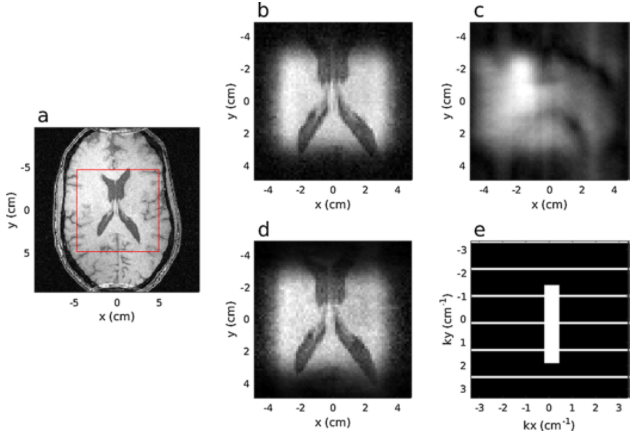Accelerating MRI data acquisition with segmented 2D pulses
A method for accelerating MRI data acquisition with segmented 2D pulses using virtual coils.

Applications
- MRI parallel imaging
- Portable MRI
- Localized spectroscopy and inner volume imaging
- Gradient echo (GRE) sequence zoom imaging for brain tumor treatment or DBS electrode placement procedures where scan-time is critical
Key Benefits & Differentiators
- Acceleration for segmented pulse technique; duration comparable to single-shot techniques
- Parallel imaging possible with single receive coil
- Reconstruction can be performed by GRAPPA and other parallel imaging techniques
- Transmit coil operates in the same excitation mode for all pulses
- Provides GRE imaging capability for T1-weighting
- Provides ability to perform real-time compensation of B1+ and non-uniformity of B0
- Permits zoomed field-of-view in 2D
Overview
In magnetic resonance imaging, large magnetic field inhomogeneity can be a significant source of spatial flip-angle variation when using ordinary, limited-bandwidth radio frequency (RF) pulses. Multidimensional RF pulses are particularly sensitive to inhomogeneity due to their extended pulse length, which decreases their bandwidth. Previous work has shown that, by breaking a 2D RF pulse into multiple undersampled k-space segments, the excitation bandwidth can be increased. However, this requires fully sampled acquisition k-space, which in turn leads to increased imaging time.
To address this issue, researchers at the University of Minnesota have developed a new method for accelerating image acquisition using segmented 2D RF pulses as virtual receivers. Data acquisition is accelerated using segmented RF pulses for excitation and refocusing, and undersampling k-space in a phase-encoded dimension that is in the direction of excitation segments. By finding the redundancy found between the data from different segments, acquired undersampled data can be used to synthesize unsampled data. Image reconstruction can be performed by applying Generalized Autocalibrating Partially Parallel Acquisition (GRAPPA) or other commonly parallel imaging techniques. This is made possible by treating the signals from each pulse segment as if they were received by a virtual coil with a spatially dependent sensitivity map. Whereas conventional techniques such as GRAPPA rely on simultaneous imaging with more than one receive coil, the virtual receive coil concept used in this method makes it suitable for scanners with single receive coils.
Phase of Development
In vivo testing performed to characterize the benefits of the method.Desired Partnerships
This technology is now available for:- License
- Sponsored research
- Co-development
Please contact our office to share your business’ needs and learn more.
Researchers
- Michael Garwood, Ph.D., Professor, Center for Magnetic Resonance Research, Department of Radiology
-
expand_more library_books References (2)
- Mullen, Michael, Alexander Gutierrez, Naoharu Kobayashi, Jarvis Haupt, and Michael Garwood. , Accelerated imaging with segmented 2d pulses using parallel imaging and virtual coils., Journal of Magnetic Resonance 305 (2019): 185-194.
- Mullen, Michael, Naoharu Kobayashi, and Michael Garwood. , Two-dimensional frequency-swept pulse with resilience to both B1 and B0 inhomogeneity., Journal of Magnetic Resonance 299 (2019): 93-100.
-
expand_more cloud_download Supporting documents (1)Product brochureAccelerating MRI data acquisition with segmented 2D pulses.pdf